Lithium-Ion Capacitor Lifetime Extension through an Optimal Thermal Management System for Smart Grid Applications
Abstract
1. Introduction
2. Experimental Methodology
2.1. Lithium-Ion Capacitor (LiC) Technology
2.2. Heat Pipe Cooling System (HPCS)
2.3. Experimental Test Bench
2.4. Test Definition and Setup
2.5. Experimental Results
3. The LiC Cycle Life Analysis and Results
3.1. Equivalent Number of Cycles
3.2. Capacity Degradation
4. Conclusions
Author Contributions
Funding
Institutional Review Board Statement
Informed Consent Statement
Data Availability Statement
Acknowledgments
Conflicts of Interest
References
- Gandoman, F.H.; Behi, H.; Berecibar, M.; Jaguemont, J.; Aleem, S.H.E.A.; Behi, M.; van Mierlo, J. Chapter 16—Reliability evaluation of Li-ion batteries for electric vehicles applications from the thermal perspectives. In Uncertainties in Modern Power Systems; Zobaa, A.F., Abdel Aleem, S.H.E., Eds.; Academic Press: Cambridge, MA, USA, 2021; pp. 563–587. [Google Scholar] [CrossRef]
- Hosen, M.S.; Karimi, D.; Kalogiannis, T.; Pirooz, A. Electro-aging model development of nickel-manganese-cobalt lithium-ion technology validated with light and heavy-duty real-life profiles. J. Energy Storage 2020, 28, 101265. [Google Scholar] [CrossRef]
- Khaleghi, S.; Karimi, D.; Beheshti, S.H.; Hosen, M.S.; Behi, H.; Berecibar, M.; van Mierlo, J. Online health diagnosis of lithium-ion batteries based on nonlinear autoregressive neural network. Appl. Energy 2021, 282, 116159. [Google Scholar] [CrossRef]
- Behi, H.; Karimi, D.; Jaguemont, J.; Gandoman, F.H.; Khaleghi, S.; van Mierlo, J.; Berecibar, M. Aluminum heat sink assisted air-cooling thermal management system for high current applications in electric vehicles. In Proceedings of the 2020 AEIT International Conference of Electrical and Electronics Technology for Automotive, AEIT Automotive 2020, Turin, Italy, 18–20 November 2020. [Google Scholar] [CrossRef]
- Akbarzadeh, M.; Jaguemont, J.; Kalogiannis, T.; Karimi, D.; He, J.; Jin, L.; Xie, P.; van Mierlo, J.; Berecibar, M. A novel liquid cooling plate concept for thermal management of lithium-ion batteries in electric vehicles. Energy Convers. Manag. 2021, 231, 113862. [Google Scholar] [CrossRef]
- Soltani, M.; Beheshti, S.H. A comprehensive review of lithium ion capacitor: Development, modelling, thermal management and applications. J. Energy Storage 2021, 34, 102019. [Google Scholar] [CrossRef]
- Karimi, D.; Behi, H.; Hosen, M.S.; Jaguemont, J.; Berecibar, M.; van Mierlo, J. A compact and optimized liquid-cooled thermal management system for high power lithium-ion capacitors. Appl. Therm. Eng. 2021, 185, 116449. [Google Scholar] [CrossRef]
- Jaguemont, J.; Karimi, D.; van Mierlo, J. Optimal passive thermal management of lithium-ion capacitors for automotive applications. IEEE Trans. Veh. Technol. 2019, 168, 10518–10524. [Google Scholar] [CrossRef]
- Soltani, M.; Ronsmans, J.; Kakihara, S.; Jaguemont, J.; van den Bossche, P.; van Mierlo, J.; Omar, N. Hybrid battery/lithium-ion capacitor energy storage system for a pure electric bus for an urban transportation application. Appl. Sci. 2018, 8, 1176. [Google Scholar] [CrossRef]
- Ding, J.; Hu, W.; Paek, E.; Mitlin, D. Review of Hybrid Ion Capacitors: From Aqueous to Lithium to Sodium. Chem. Rev. 2018, 118, 6457–6498. [Google Scholar] [CrossRef]
- Hamidi, S.A.; Manla, E.; Nasiri, A. Li-ion batteries and Li-ion ultracapacitors: Characteristics, modeling and grid applications. In Proceedings of the 2015 IEEE Energy Conversion Congress and Exposition (ECCE), Montreal, QC, Canada, 20–24 September 2015; Institute of Electrical and Electronics Engineers Inc.: Montreal, QC, Canada, 2015; pp. 4973–4979. [Google Scholar] [CrossRef]
- Zhang, J.; Liu, X.; Wang, J.; Shi, J.; Shi, Z. Different types of pre-lithiated hard carbon as negative electrode material for lithium-ion capacitors. Electrochim. Acta 2016, 187, 134–142. [Google Scholar] [CrossRef]
- Fell, C.R.; Sun, L.; Hallac, P.B.; Metz, B.; Sisk, B. Investigation of the Gas Generation in Lithium Titanate Anode Based Lithium Ion Batteries. J. Electrochem. Soc. 2015, 162, A1916–A1920. [Google Scholar] [CrossRef]
- Huang, F.; Ma, J.; Xia, H.; Huang, Y.; Zhao, L.; Su, S.; Kang, F.; He, Y.B. Capacity Loss Mechanism of the Li4Ti5O12 Microsphere Anode of Lithium-Ion Batteries at High Temperature and Rate Cycling Conditions. ACS Appl. Mater. Interfaces 2019, 11. [Google Scholar] [CrossRef]
- Yang, Z.; Huang, Q.; Li, S.; Mao, J. High-temperature effect on electrochemical performance of Li4Ti5O12 based anode material for Li-ion batteries. J. Alloys Compd. 2018, 753, 192–202. [Google Scholar] [CrossRef]
- Handel, P.; Fauler, G.; Kapper, K.; Schmuck, M.; Stangl, C.; Fischer, R.; Uhlig, F.; Koller, S. Thermal aging of electrolytes used in lithium-ion batteries—An investigation of the impact of protic impurities and different housing materials. J. Power Sources 2014, 267, 255–259. [Google Scholar] [CrossRef]
- Smart, M.C.; Ratnakumar, B.V.; Whitacre, J.F.; Whitcanack, L.D.; Chin, K.B.; Rodriguez, M.D.; Zhao, D.; Greenbaum, S.G.; Surampudi, S. Effect of Electrolyte Type upon the High-Temperature Resilience of Lithium-Ion Cells. J. Electrochem. Soc. 2005, 152, A1096. [Google Scholar] [CrossRef]
- el Ghossein, N.; Sari, A.; Venet, P.; Genies, S.; Azaïs, P. Post-Mortem Analysis of Lithium-Ion Capacitors after Accelerated Aging Tests. J. Energy Storage 2021, 33, 102039. [Google Scholar] [CrossRef]
- Behi, H.; Behi, M.; Karimi, D.; Jaguemont, J.; Ghanbarpour, M.; Behnia, M.; Berecibar, M.; van Mierlo, J. Heat pipe air-cooled thermal management system for lithium-ion batteries: High power applications. Appl. Therm. Eng. 2020, 116240. [Google Scholar] [CrossRef]
- Karimi, D.; Behi, H.; Jaguemont, J.; el Baghdadi, M.; van Mierlo, J.; Hegazy, O. Thermal Concept Design of MOSFET Power Modules in Inverter Subsystems for Electric Vehicles. In Proceedings of the 2019 9th International Conference on Power and Energy Systems (ICPES), Perth, WA, Australia, 10–12 December 2019. [Google Scholar] [CrossRef]
- Soltani, M.; Berckmans, G.; Jaguemont, J.; Ronsmans, J.; Kakihara, S.; Hegazy, O.; van Mierlo, J.; Omar, N. Three dimensional thermal model development and validation for lithium-ion capacitor module including air-cooling system. Appl. Therm. Eng. 2019, 153, 264–274. [Google Scholar] [CrossRef]
- Möller, S.; Karimi, D.; Vanegas, O.; el Baghdadi, M.; Kospach, A.; Lis, A.; Hegazy, O.; Abart, C.; Offenbach, Â.B.Â. Application considerations for Double Sided Cooled Modules in Automotive Environment Double Sided Cooled Modules in Automotive Environment. In Proceedings of the 11th International Conference on Integrated Power Electronics Systems (CIPES), Berlin, Germany, 24–26 March 2020. [Google Scholar]
- Karimi, D.; Behi, H.; Jaguemont, J.; Sokkeh, M.A.; Kalogiannis, T.; Hosen, M.S.; Berecibar, M.; van Mierlo, J. Thermal performance enhancement of phase change material using aluminum-mesh grid foil for lithium-capacitor modules. J. Energy Storage 2020, 30. [Google Scholar] [CrossRef]
- Behi, H.; Karimi, D.; Behi, M.; Ghanbarpour, M.; Jaguemont, J.; Sokkeh, M.A.; Gandoman, F.H.; Berecibar, M.; van Mierlo, J. A new concept of thermal management system in Li-ion battery using air cooling and heat pipe for electric vehicles. Appl. Therm. Eng. 2020, 174. [Google Scholar] [CrossRef]
- Behi, H.; Karimi, D.; Gandoman, F.H.; Akbarzadeh, M.; Khaleghi, S.; Kalogiannis, T.; Hosen, M.S.; Jaguemont, J.; van Mierlo, J.; Berecibar, M. PCM assisted heat pipe cooling system for the thermal management of an LTO cell for high-current profiles. Case Stud. Therm. Eng. 2021, 25, 100920. [Google Scholar] [CrossRef]
- Behi, M.; Shakorian-poor, M.; Mirmohammadi, S.A.; Behi, H.; Rubio, J.I.; Nikkam, N.; Farzaneh-Gord, M.; Gan, Y.; Behnia, M. Experimental and numerical investigation on hydrothermal performance of nanofluids in micro-tubes. Energy 2020, 193, 116658. [Google Scholar] [CrossRef]
- Behi, H.; Ghanbarpour, M.; Behi, M. Investigation of PCM-assisted heat pipe for electronic cooling. Appl. Therm. Eng. 2017, 127, 1132–1142. [Google Scholar] [CrossRef]
- Behi, M.; Mirmohammadi, S.A.; Ghanbarpour, M.; Behi, H.; Palm, B. Evaluation of a novel solar driven sorption cooling/heating system integrated with PCM storage compartment. Energy 2018, 164, 449–464. [Google Scholar] [CrossRef]
- Behi, H. Experimental and Numerical Study on Heat Pipe Assisted PCM Storage System. Master’s Thesis, Royal Institute of Technology, Stockholm, Sweden, 2015. [Google Scholar]
- Behi, H.; Karimi, D.; Behi, M.; Jaguemont, J.; Ghanbarpour, M.; Behnia, M.; Berecibar, M.; van Mierlo, J. Thermal management analysis using heat pipe in the high current discharging of lithium-ion battery in electric vehicles. J. Energy Storage 2020, 32, 101893. [Google Scholar] [CrossRef]
- Behi, H.; Karimi, D.; Jaguemont, J.; Gandoman, F.H.; Kalogiannis, T.; Berecibar, M.; van Mierlo, J. Novel thermal management methods to improve the performance of the Li-ion batteries in high discharge current applications. Energy 2021, 120165. [Google Scholar] [CrossRef]
- Uno, M.; Kukita, A. Cycle Life Evaluation Based on Accelerated Aging Testing for Lithium-Ion Capacitors as Alternative to Rechargeable Batteries. IEEE Trans. Ind. Electron. 2016, 63, 1607–1617. [Google Scholar] [CrossRef]
- Gelman, A.; Imbens, G. Why High-Order Polynomials Should Not Be Used in Regression Discontinuity Designs. J. Bus. Econ. Stat. 2019, 37, 447–456. [Google Scholar] [CrossRef]
- Park, H.; Kim, M.; Xu, F.; Jung, C.; Hong, S.M.; Koo, C.M. In situ synchrotron wide-angle X-ray scattering study on rapid lithiation of graphite anode via direct contact method for Li-ion capacitors. J. Power Sources 2015, 283, 68–73. [Google Scholar] [CrossRef]
- Kariya, B.H.A. Development of an Air-Cooled, Loop-Type Heat Pipe with Multiple Condensers; Massachusetts Institute of Technology: Cambridge, MA, USA, 2012. [Google Scholar]
- Sheikholeslami, M.; Ganji, D.D. Heat transfer enhancement in an air to water heat exchanger with discontinuous helical turbulators; experimental and numerical studies. Energy 2016, 116, 341–352. [Google Scholar] [CrossRef]
- Sivakkumar, S.R.; Pandolfo, A.G. Evaluation of lithium-ion capacitors assembled with pre-lithiated graphite anode and activated carbon cathode. Electrochim. Acta 2012, 65, 280–287. [Google Scholar] [CrossRef]
- Principle and Features of Lithiumion Capacitormusashi Energy Solutions Co., Ltd., (n.d.). Available online: https://www.musashi-es.co.jp/en/lithium_ion_capacitor/whats/ (accessed on 29 April 2021).
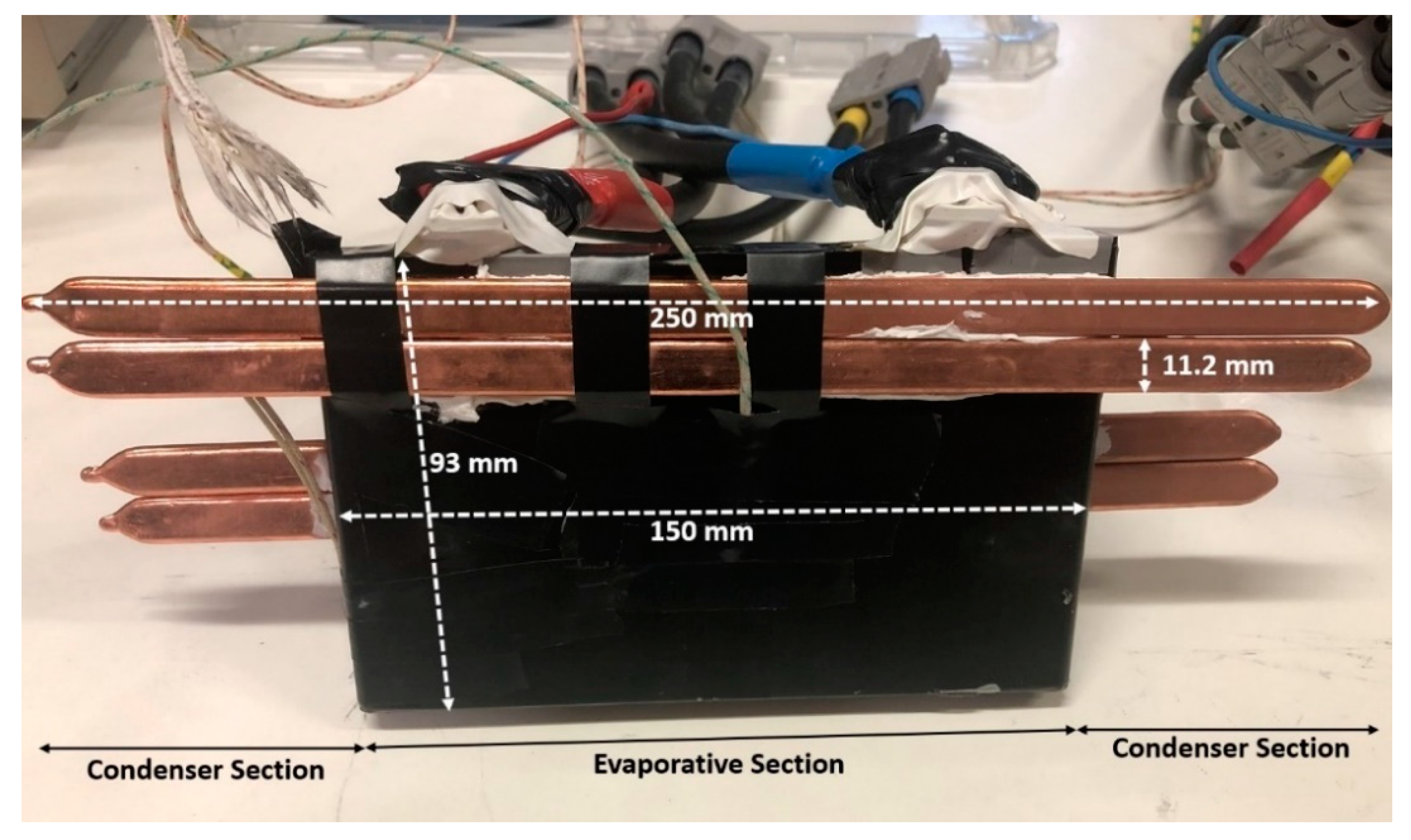
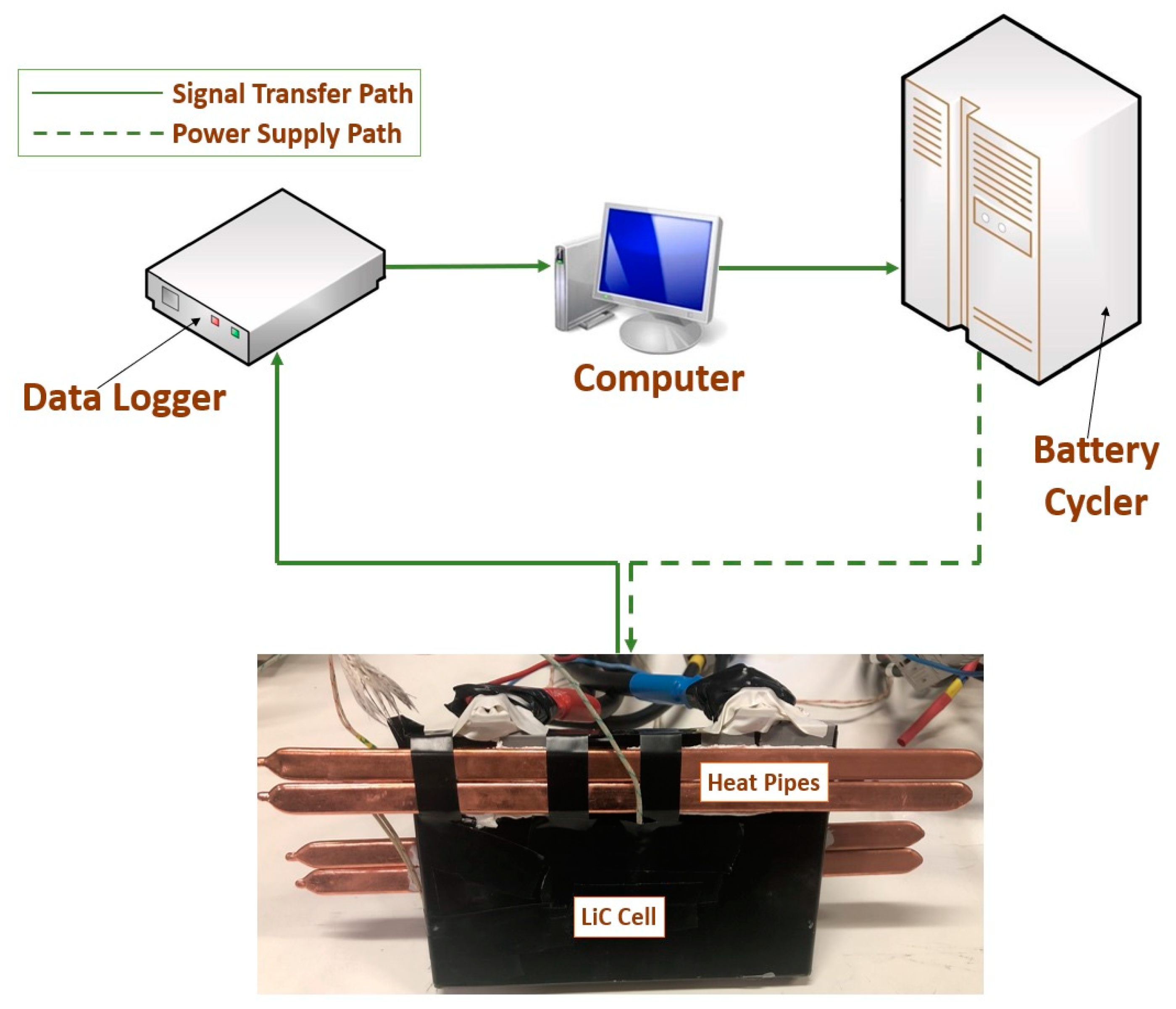
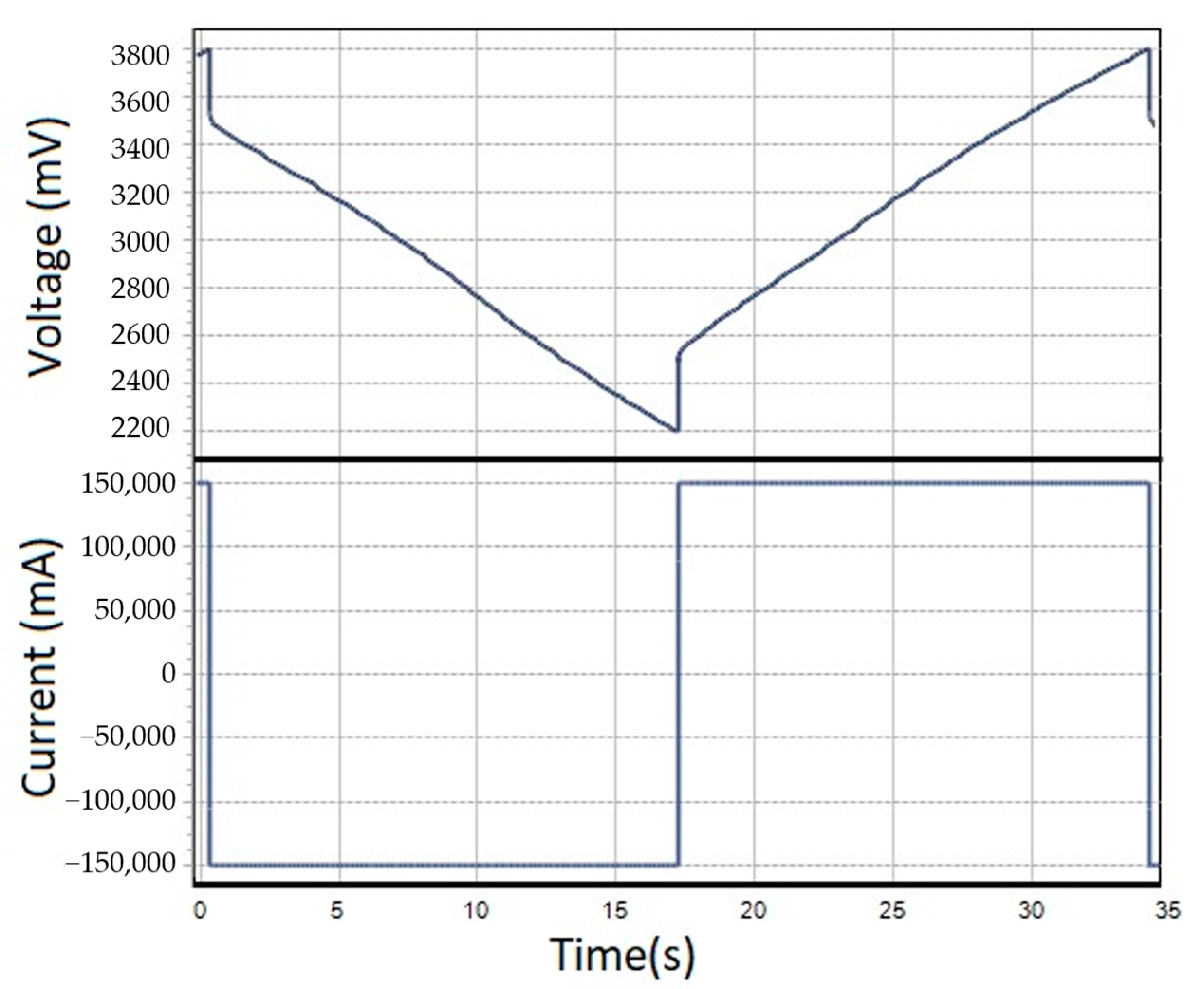
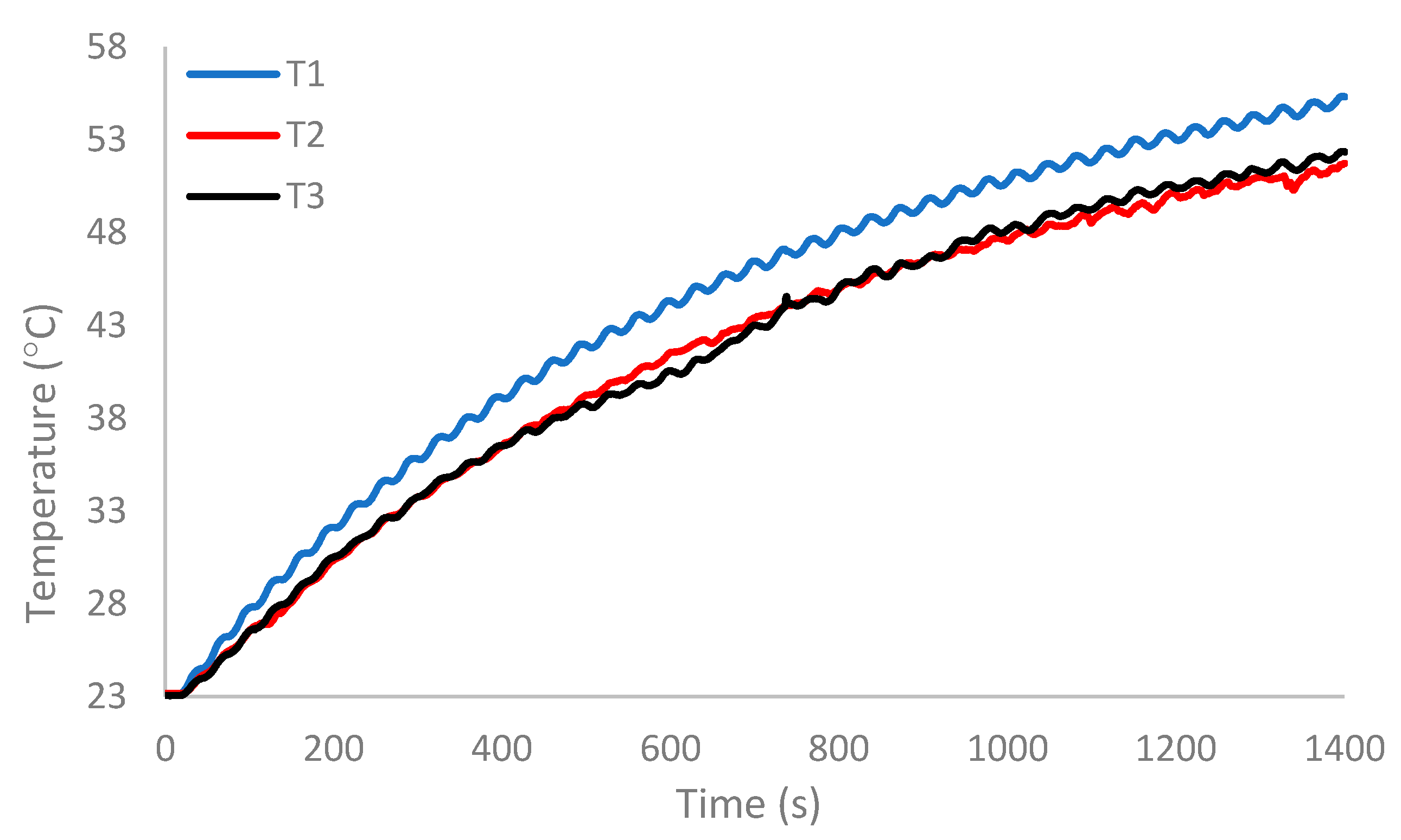
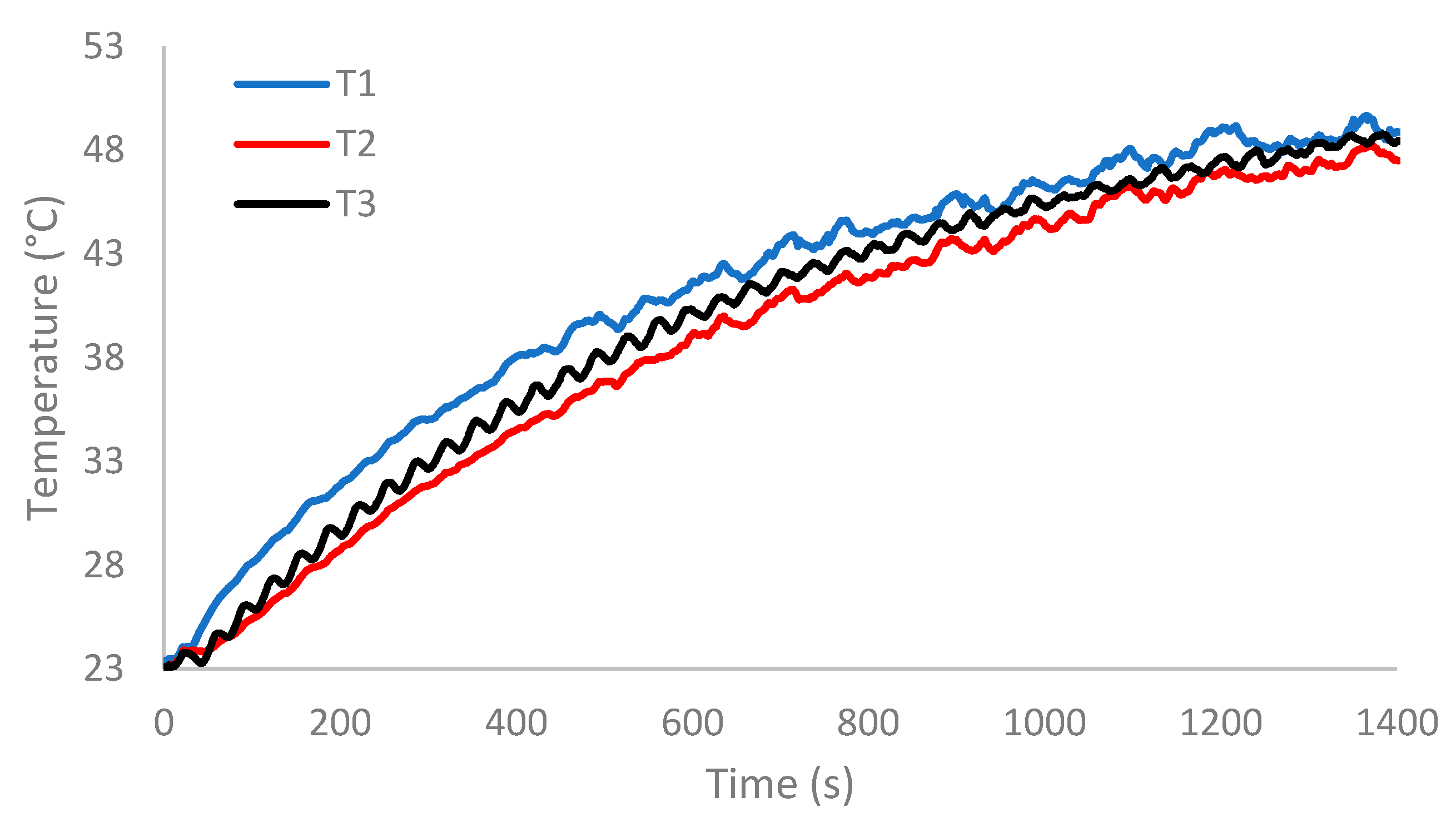
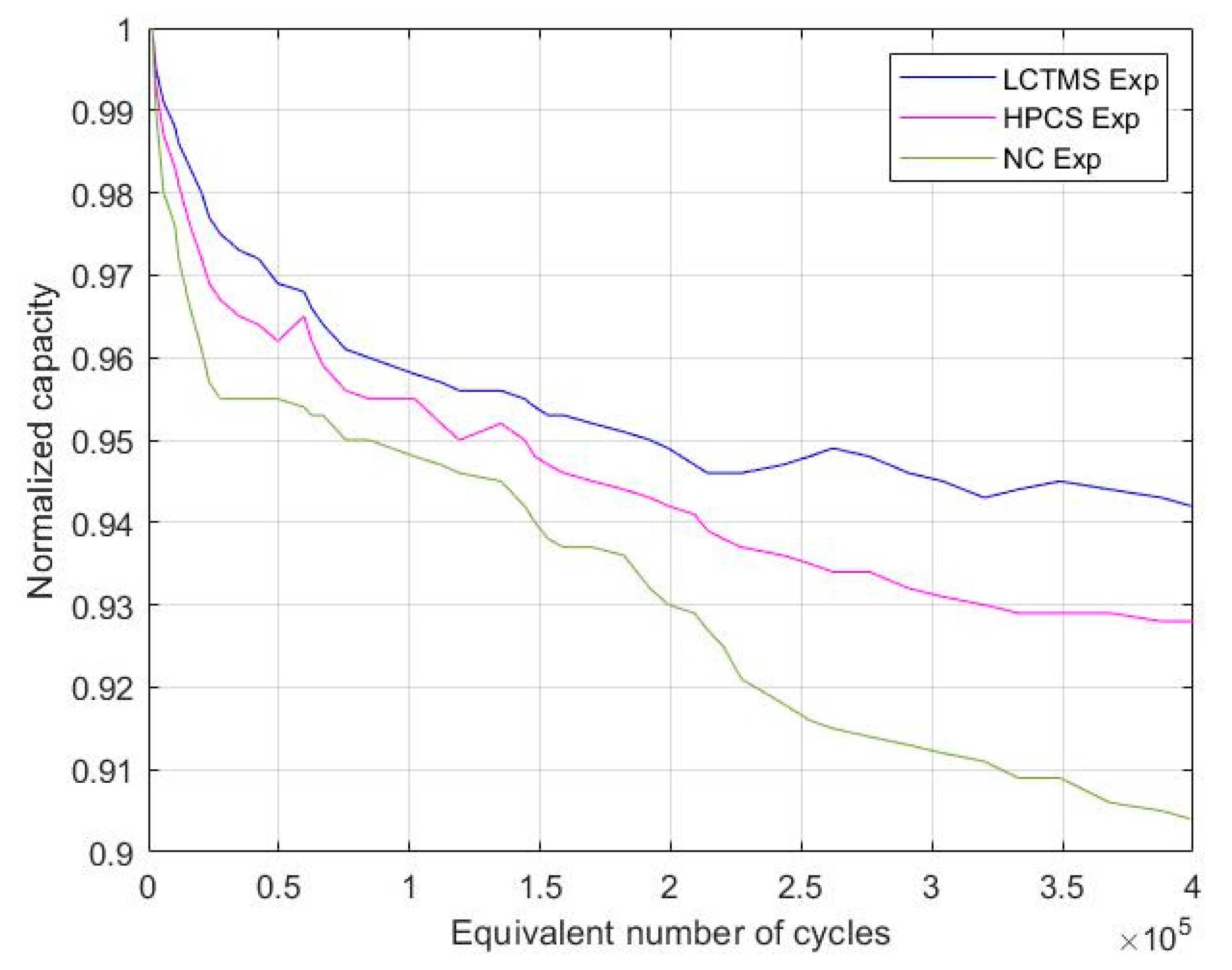

| Parameters | Value | Unit |
|---|---|---|
| Capacitance | 2300 | F |
| Voltage range | 2.2 to 3.8 | V |
| Weight | 355 | grams |
| Current | 1–1000 | A |
| Energy density | 8 | Wh/kg |
| Width | 150 | mm |
| Height | 93 | mm |
| Thickness | 15.5 | mm |
| Operating temperature | −30 to +70 | °C |
| Parameters | Value | Unit |
|---|---|---|
| Length | 250 | mm |
| Width | 11.2 | mm |
| Thickness | 3.5 | mm |
| Working fluid | Distilled water | - |
| Wick structure | Sintered | - |
| Thermal conductivity | 8212 | W/m.K |
| Cooling power | 100 | W |
| Operating temperature | 30 to 120 | °C |
| Effective length | 125 | mm |
| Scenario | T1 | T2 | T3 |
|---|---|---|---|
| Scenario 1 | 55.3 °C | 52.3 °C | 51.7 °C |
| Scenario 2 | 48.8 °C | 48.4 °C | 47.5 °C |
| Temperature reduction | 11.7% | 7.5% | 8% |
| Case Study Name | Initial Temperature | Cell Temperature after 1400 s | Capacity Degradation for 4 × 105 Eq-Cycles |
|---|---|---|---|
| NC | 23 °C | 55.3 °C | 90.4% |
| HPCS | 23 °C | 48.8 °C | 92.5% |
| LCTMS | 23 °C | 32.5 °C | 94.2% |
| Case Study Name | a | b | c |
|---|---|---|---|
| NC | 0.9364 | −8.828 × 10−8 | 0.00001 |
| HPCS | 0.9591 | −8.994 × 10−8 | 0.00835 |
| LCTMS | 0.9615 | −4.984 × 10−8 | 0.00012 |
| Case Study Name | Initial Temperature | Cell Temperature | Capacity EoL |
|---|---|---|---|
| NC | 23 °C | 55.3 °C | 1.78 × 106 eq-cycle |
| HPCS | 23 °C | 48.8 °C | 2.13 × 106 eq-cycle |
| LCTMS | 23 °C | 32.5 °C | 3.69 × 106 eq-cycle |
Publisher’s Note: MDPI stays neutral with regard to jurisdictional claims in published maps and institutional affiliations. |
© 2021 by the authors. Licensee MDPI, Basel, Switzerland. This article is an open access article distributed under the terms and conditions of the Creative Commons Attribution (CC BY) license (https://creativecommons.org/licenses/by/4.0/).
Share and Cite
Karimi, D.; Khaleghi, S.; Behi, H.; Beheshti, H.; Hosen, M.S.; Akbarzadeh, M.; Van Mierlo, J.; Berecibar, M. Lithium-Ion Capacitor Lifetime Extension through an Optimal Thermal Management System for Smart Grid Applications. Energies 2021, 14, 2907. https://doi.org/10.3390/en14102907
Karimi D, Khaleghi S, Behi H, Beheshti H, Hosen MS, Akbarzadeh M, Van Mierlo J, Berecibar M. Lithium-Ion Capacitor Lifetime Extension through an Optimal Thermal Management System for Smart Grid Applications. Energies. 2021; 14(10):2907. https://doi.org/10.3390/en14102907
Chicago/Turabian StyleKarimi, Danial, Sahar Khaleghi, Hamidreza Behi, Hamidreza Beheshti, Md Sazzad Hosen, Mohsen Akbarzadeh, Joeri Van Mierlo, and Maitane Berecibar. 2021. "Lithium-Ion Capacitor Lifetime Extension through an Optimal Thermal Management System for Smart Grid Applications" Energies 14, no. 10: 2907. https://doi.org/10.3390/en14102907
APA StyleKarimi, D., Khaleghi, S., Behi, H., Beheshti, H., Hosen, M. S., Akbarzadeh, M., Van Mierlo, J., & Berecibar, M. (2021). Lithium-Ion Capacitor Lifetime Extension through an Optimal Thermal Management System for Smart Grid Applications. Energies, 14(10), 2907. https://doi.org/10.3390/en14102907











